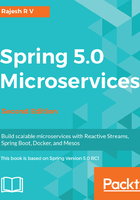
An example of a travel agent portal
This third example is a simple travel agent portal application. In this example, we will see both synchronous REST calls as well as asynchronous events.
In this case, portal is just a container application with multiple menu items or links in the portal. When specific pages are requested, for example, when the menu is clicked or a link is clicked, they will be loaded from the specific microservices:
The architecture of the Travel Agent Portal backed with multiple microservices is shown as follows:

When a customer requests a booking, the following events will take place internally:
- The travel agent opens the flight UI, searches for a flight, and identifies the right flight for the customer. Behind the scenes, the flight UI will be loaded from the Flight microservice. The flight UI only interacts with its own backend APIs within the Flight microservice. In this case, it makes a REST call to the Flight microservice to load the flights to be displayed.
- The travel agent then queries the customer details by accessing the customer UI. Similar to the flight UI, the customer UI will be loaded from the Customer microservices. Actions in the customer UI will invoke REST calls on the Customer microservice. In this case, the customer details will be loaded by invoking appropriate APIs on the Customer microservice.
- Then the travel agent checks the visa details to see the eligibility to travel to the selected country. This will also follow the same pattern as mentioned in the previous two points.
- Then the travel agent makes a booking using the booking UI from the Booking microservices, which again follows the same pattern.
- The payment pages will be loaded from the Payment microservice. In general, the payment service will have additional constraints, including the Payment Card Industry Data Security Standard (PCIDSS) compliance, such as protecting and encrypting data in motion and data at rest. The advantage of the microservices approach is that none of the other microservices need to be considered under the purview of PCIDSS as opposed to the monolithic application, where the complete application comes under the governing rules of PCIDSS. Payment also follows the same pattern described earlier.
- Once the booking is submitted, the Booking Service calls the flight service to validate and update the flight booking. This orchestration is defined as a part of the Booking microservices. Intelligence to make a booking is also held within the Booking microservices. As a part of the booking process, it also validates, retrieves, and updates the Customer microservice.
- Finally, the Booking microservice sends a booking event, which the Notification Services picks up, and sends a notification to the customer.
The interesting factor here is that we can change the user interface, logic, and data of a microservice without impacting any other microservices.
This is a clean and neat approach. A number of portal applications could be built by composing different screens from different microservices, especially for different user communities. The over all behavior and navigation will be controlled by the portal application.
The approach has a number of challenges unless the pages are designed with this approach in mind. Note that the site layouts and static contents will be loaded from the Content Management System (CMS) as layout templates. Alternately, this could be stored in a web server. The site layout may have fragments of User Interfaces, which will be loaded from the microservices at runtime.